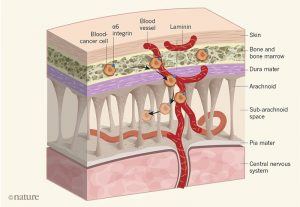Frank Winkler in Nature:
 If malignant cells from solid or blood cancers enter the central nervous system (CNS) and grow there, the treatment options and clinical outlook deteriorate rapidly. In a type of leukaemia called acute lymphoblastic leukaemia (ALL), invasion of the CNS commonly occurs. To try to limit this, people with the condition often receive radiation or chemotherapy that targets the CNS. If more-effective and less-toxic approaches became available to prevent disease spread to the CNS, this might benefit many people with ALL. Writing in Nature, Yao et al.1 report a hitherto unknown route that ALL cells use to enter the CNS, and suggest a possible therapeutic approach that is worth investigating.
If malignant cells from solid or blood cancers enter the central nervous system (CNS) and grow there, the treatment options and clinical outlook deteriorate rapidly. In a type of leukaemia called acute lymphoblastic leukaemia (ALL), invasion of the CNS commonly occurs. To try to limit this, people with the condition often receive radiation or chemotherapy that targets the CNS. If more-effective and less-toxic approaches became available to prevent disease spread to the CNS, this might benefit many people with ALL. Writing in Nature, Yao et al.1 report a hitherto unknown route that ALL cells use to enter the CNS, and suggest a possible therapeutic approach that is worth investigating.
When leukaemia spreads into the CNS, this process, termed metastasis, is mainly limited to the region known as the subarachnoid space, which contains cerebrospinal fluid that bathes the brain and spinal cord. The subarachnoid space is surrounded by membranes called the dura mater, the pia mater and the arachnoid, which are collectively called the meninges and are also colonized by cancer cells (Fig. 1). Yao and colleagues used mouse models of ALL to investigate how human leukaemia cells spread into the CNS. They focused on the enzyme PI3K, which is a key regulator of signalling pathways needed for growth, survival and invasion by cancer cells.
More here.
